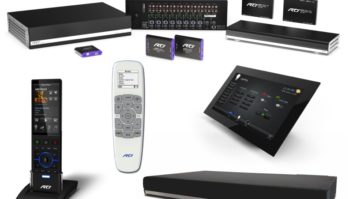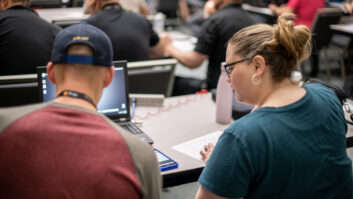Control freaks felt comfortable at the CEDIA Expo, where suppliers applied new technologies and methods for centrally controlling home systems throughout the house from the same touch screen or keypad.
Touch screens have been the preferred way to integrate whole-house control of multiple systems, but Elan showed an in-wall controller that it said combines the advantages of touch screens and keypad systems. Crestron touted a handheld Wi-Fi remote to control all home systems. And Russound showed its first tabletop touch screen for its RNET distributed-audio system.
At least two more companies — Colorado vNet and startup Savant — also developed new products to give installers the ability to integrate control of all home systems into a single in-wall controller.
Here is a sampling of new control options appearing at the Expo:
Colorado vNet: The company plans a fourth-quarter firmware upgrade enabling its in-wall 7-inch color touch screen/amplifiers to control its previously separate Aura lighting and control system, which was controlled by dedicated keypads and touch screens. The 7-inch touchscreen/amplifiers are part of the company’s Ethernet-based Vibe multi-room audio system, which ships audio over Ethernet cables to the touch screens. The touch screens convert the audio signals to analog, amplify the signal, and power architectural speakers in the same room.
Control4: The company upgraded the operating system in its multi-room-audio and home-control system to run 3x to 5x faster, allow installers to download firmware upgrades without a truck roll, and enable homeowners to control their home’s systems remotely from any Web browser.
Control4 uses wireless ZigBee to control home A/V, lighting, and other home-control systems, including legacy systems that lack ZigBee. The company also uses wired and wireless Ethernet to distribute music to amplified tabletop clients. The company’s products include a music server.
Convergent Living: The company added built-in drivers for two-way control of custom systems from more than 10 additional suppliers for its Companion touch screen controllers, which require no outboard “central brain” to integrate the control of disparate home systems, including HVAC and A/V.
The controllers interface directly with serial-port devices and, via other-brand accessories, to IR-and IP-controlled components, delivering plug-and-play control with Flash-animated interface designs, the company said.
The latest drivers operate the Netstreams Digilinx multi-room system, Polk’s XM Tuner, Russound RNET-databus multiroom systems, Clipsal C-Bus lighting, Lutron’s Homeworks lighting system, UPB Digital Lighting, NuVo Concerto and Essentia preamps, and Custom Windows Media Center/Xbox.
The in-wall Companion 8 at a suggested $3,450 and Companion 15, a desk or surface-mount model at $4,485, are part of a suite of controller that include the Muse, a Wi-Fi handheld at $4,357.
Crestron: The newest touch panel in the company’s Isys touch panel series is the company’s first handheld remote with two-way Wi-Fi connectivity to control home systems, including multi-room audio, HVAC, lighting, and motorized shades. It features hard buttons and LCD touch panel.
By using two-way Wi-Fi, the $1,990-suggested TPMC-4X displays dynamic graphics, improved status feedback, and streaming video from security cameras or other sources in motion jpeg format.
The TPMC-4X connects wirelessly to Crestron control systems that integrate with other home systems. It features 3.5-inch touch screen, 17 programmable backlit buttons, and on-screed virtual keyboard to select songs for playback from a music server.
Elan: The company touted its Ole in-wall controller as a cross between a touch panel and a keypad. The $380-suggested Ole, said to be the first with an organic LED (OLED) display, is promoted as delivering keypad simplicity with an LCD touch panel’s speed.
To accomplish these goals, Elan uses thin touch-sensitive film that slides into the controller. Different films have 13, 17 or 25 touch-sensitive hot spots to deliver basic control over a multi-room audio system to control over multiple home systems. A 1-inch OLED display shows icons and displays metadata.
To integrate with different home decors, the films feature photographic-quality pictures that are backlit. Initially, eight families of film styles will be available, including a flamenco-themed film.
Russound: The UNO-TS2 is the first tabletop version of the company’s in-wall touch screen controller for multiroom-audio systems based on its RNET databus system. Due in October at a suggested $1,499, the device features 3.75-inch color LCD display, 320 by 240 resolution, and IR receiver hidden behind a tinted window for handheld-remote control of the RNET system, RNET-equipped source components such as tuners and media servers, and legacy source components.
Hard keys are included for common functions such as volume and channel selection, and touch panel buttons can be customized. The screen also displays source metadata.
Savant: The startup unveiled a multi-room A/V system that integrates with other suppliers’ home-control systems. Due in March, it is said to eliminate days of programming, reducing a customer’s costs by as much as $10,000 to $15,000 on a hypothetical system whose installation and hardware costs would run $150,000.
To program a system, installers click and drag icons of various Savant and other-brand products to create a block diagram. The installer then hits a compile button to configure the system’s software. For each component, installers select the features they want to use, and the features appear on the system’s touch panels.
The brain of Savant’s system is a multi-zone-A/V preamp/surround-processor/controller with video scaler and video switching. It’s controlled from in-wall touch panels and handheld RF remotes. Savant also offers a multichannel amplifier, home theater amplifier, and music server. Audio signal is routed through the house over speaker cables, and video is routed over various types of video cables, including HDMI.











